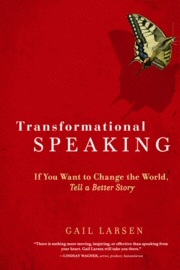Keynoting: An Art Form Unto Itself
Recently AOL ran a story about “The Top Ten Most Overpaid Jobs.” High on the list were “motivational speakers” with warmed-over messages. While that delivers a sting of truth in some cases, I believe speakers who build lasting careers really earn their fees and then some. Here’s why:
Speaking takes many forms. Some speakers are successful in intimate settings, other on large platforms. Few do both with equal ease. Shakespeare’s exhortation “to thy own self be true” is absolute wisdom in the case of where to invest your energy in building a speaking career.
I’ve been in the speaking world for 25 years. While I maintain a passionate interest in introducing new voices with something of meaning to say, I, too, have learned the hard way that the following do not a keynoter make:
A successful track record, whether it be consulting, or medicine or any other field
Several books to your credit affirming your expertise
Experience in facilitating groups and presenting workshops
Confidence in your ability to take the next step
These, however, constitute a great foundation for moving into keynoting. But keynoting is an art form unto itself, demanding different skills and orientation than training and consulting.
Anything I say excludes celebrity. A celebrity can clear his or her throat and get a standing ovation. If you were a celebrity, you wouldn’t be reading this.
Keynoters are hired to:
1. Set the stage for a meeting – and build attendance with their name recognition (or a powerful subject) if it is an association or public event
2. Wow the audience with insight, wisdom, humor and direct application to their challenges
3. Make them laugh. You don’t have to be funny to speak, only to get paid the big bucks. Laughter is the shortest distance between two people, so a tough message delivered on the wings of laughter usually finds its mark.
4. Deliver the message with stories that bring home the points.
5. Demonstrate the intellectual foundation that satisfies the audience’s need for authority and credibility
6. Create an emotional connection with the audience that speaks to their hearts
7. Extend a call to action that gets them committed to diving into the rest of the meeting with confidence they’ll get what they need and that they have what it takes to meet the challenge.
8. Create a mood of excitement about what’s to come
9. Give rise to conversation among the participants as they continue to reflect on the message
10. Make people glad they came and leave them wanting more
When you’re done, the organizer will breathe a sigh of relief that you came through and his job is secure. The CEO may take you aside and tell you her personal challenges because you touched her heart. Participants will leave the session reflecting on what you stirred up in them and confident they can rise to the challenges ahead. And after the accolades, you’ll go back to your hotel room or the airport where you have to be your own hero because no once else is aware of the miracle you just performed.
(c) 2003 Gail Larsen.
Gail Larsen is the founder of Real Speaking. She supports people in discovering and giving voice to the message that is theirs to speak, then identify the markets and format where it will be heard.





